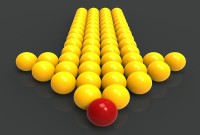- Home
- Business Processes
- Industry Knowledge
- Aerospace Industry
- Automotive Industry
- Banking Domain
- BFSI Industry
- Consumer/ FMCG Industry
- Chemicals Industry
- Engineering & Construction
- Energy Industry
- Education Domain
- Finance Domain
- Hospitality Domain
- Healthcare Industry
- Insurance Domain
- Retail Industry
- Travel and Tourism Domain
- Telecom Industry
- Leadership Skills
- eLearning
- Home
- Leadership
- Leadership & Management
- The Great Man Theory
The Great Man Theory
The great man theory of leadership is a 19th-century idea that states a person is either a natural-born leader or not. Some people are born with the necessary leadership attributes that help them create a great impact on society, politics, or the military. The theory focuses on identifying the innate qualities and characteristics possessed by great men.
What is Great Man Theory?
This theory is linked to the work of the historian “Thomas Carlyle” and was proposed during the 19th century (1840’s) according to which history can be largely explained by the impact of great men or heroes and that great leaders are born and not made. According to this theory capacity for leadership is inborn that is a person is either a natural born leader or not. These born leaders are highly influential individuals, gifted with divine inspiration and the right characteristics like charisma, intelligence, wisdom, political skill etc. with a capability to have a decisive historical impact. The theories that were developed were called “great man” theories because they focused on identifying the innate qualities and characteristics possessed by great social, political, and military leaders.
Great Person Theory:
In earlier times leadership was considered mainly as a quality associated with the males however with the emergence of many great women leaders in future, this theory was recognized as the great person theory in place of great men theory.
Quotes on Great Man Theory:
“The history of the world is but the biography of great men” - Thomas Carlyle
"The goal of humanity lies in its highest specimens" – Nietzsche (Untimely Meditations)
Overview of Great Person Theory:
As much of the literature available on Theories of Leadership is a product of last two centuries, early research on leadership was primarily based on the study of people who were known as great leaders. Hence this theory is based on the assumption that leaders are born and not made and that the great leaders will arise when there is a great need for them, as the right man for the job seems to emerge almost magically to take control of a situation and lead a group of people into safety or success.
This theory presented a primary view of leadership as it was said that history is nothing but stories of great men. Advocates of this theory believed there were a few exceptional men in each generation who were born with qualities and characteristics that caused other individuals to follow them. These great men were believed to be born with the necessary attributes that set them apart from others and that these traits are responsible for their assuming positions of power and authority.
A leader is a hero who accomplishes goals against all odds for his followers. From an early age, these leaders could attract followers through the magnetism of their personalities and had the ability to direct the group in ways that produced significant changes to society. This theory was also supported by American scholar Frederick Adams Woods who in his work investigated 386 rulers in Western Europe from the 12th century till the French revolution in the late 18th century and their influence on the course of historical events.
One of the main reasons for evolution of this theory was that in those times people of a lesser social status had fewer opportunities to practice and achieve leadership roles, and research looked only at people who were already successful leaders. These successful heroes were either aristocratic ruler, who achieved the position through birthright or individuals with personal charisma that they emerged great against all odds. Their ability to lead others was not found in a set of skills that could be learned, but was thought to be a unique, internalized characteristic that was inherent in personality to such a degree as to be part of a leader's genetic structure. This fact contributed to the idea that leadership is an inherent ability. Leadership is believed to be provided by people possessed of special skills and/or qualities distinguishing them from other people who don’t have these.
Criticism / Arguments against - The Great Person Theory of Leadership
The great person theory was popularized in the 1840s by Thomas Carlyle, and in 1860 Herbert Spencer formulated a counter-argument that has remained influential till present. He argued that such great men are actually the products of their societies, and that their actions would be impossible without the social conditions built before their lifetimes. Leaders were the products of the society in which they lived. Spencer wrote, "You must admit that the genesis of a great man depends on the long series of complex influences which has produced the race in which he appears, and the social state into which that race has slowly grown....Before he can remake his society, his society must make him." – The Study of Sociology.
Until the last years, similar in some ways to "Great Man Theories” another theory gained popularity that assumed that people inherit certain qualities and traits that make them better suited to leadership. These theories were known as “Trait Theories of Leadership”, our next article in this section discusses these theories in detail.
Related Links
You May Also Like
-
Substitutes for leadership theory is based on understanding the context within which leadership occurs. Different situational factors can enhance, neutralize, or substitute for leader behaviors like under certain circumstances, situational factors may substitute for leadership. These substitutes are of two types - substitutes and neutralizers. Substitutes take away from the leader's power and help group members increase their performance. Neutralizers only remove influence from the leader.
-
Power is the ability to exercise influence or control over others. Leadership involves authority and it is very important for leaders to understand what type of power they're using. The 5 Types of Power in Leadership are Coercive power, expert power, legitimate power, referent power, and reward power. Authority is the right to command and extract obedience from others. It comes from the organization and it allows the leader to use power.
-
Authentic leadership is a new approach to leadership in which leaders are genuine, self-aware, transparent, build honest relationships, and work on an ethical foundation. Authenticity is one of the core values of leadership. Authentic leaders have truthful self-concepts and they inspire by promoting openness by acting in a real, genuine, and sincere way. Authenticity requires self-awareness and the ability to act in accordance with one's true self.
-
Neo-Emergent Leadership theory supports that leadership is created through the emergence of information. Leaders can only be recognized after a goal is met. Follower’s perception of leaders is influenced by the ways these goals were accomplished.
-
The Hersey and Blanchard Situational Theory model suggests that a leader must adapt his leadership style based on task and relationship behaviors appropriate to the situation. Leadership style is dependent on the maturity level and abilities of followers. Under this model, successful leadership is both task-relevant and relationship-relevant.
-
What are the functions which a leader does to establish as a leader? What are the activities undertaken by them to become great leaders, rather revolutionary leaders? The most important tasks done by a leader in all situations are defining the vision, mission, and goals, leading the team, administrative functions, motivating followers, decision making and conflict resolution, and continuous development.
-
The Leader-Member Exchange Theory (LMX), also called the Vertical Dyad Linkage Theory is a relationship-based approach that focuses on the two-way (dyadic) relationship to get the best from all team members. How leaders maintain their position in groups and develop an exchange with each of their subordinates. How leaders and members develop relationships that can contribute to growth or hinder development.
-
Contingency Theories in Action
Contingency theory suggests matching the best leader to a specific situation based on situational factors and the leadership style. The practical application of theory can be done in various ways. The workplace example is to determine the best candidate for a given set of requirements using the LPC score. Applying the model to determine a leader's ability to adapt in the scenario of a new project etc..
-
Leader-Participation Model provides a set of rules to determine the form and amount of participative decision making. It helps identifies different ways a decision can be made based on the degree of follower participation. It proposes a method for leaders to involve all members of the organization work together to make decisions.
-
Process & Stages of Creativity
Creative ideas do not come just like that. There is a process to it. There are a number of techniques of creativity to support the generation of ideas but the widely practiced ones are brainstorming and lateral thinking. Most innovations are not so much the product of sudden insights as they are the result of a conscious process that often goes through multiple stages. The creative process can be divided into four stages of preparation, incubation, evaluation, and implementation.
Explore Our Free Training Articles or
Sign Up to Start With Our eLearning Courses

About Us
Learning
© 2023 TechnoFunc, All Rights Reserved










